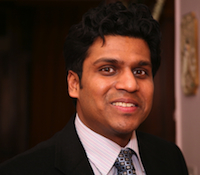Invisible system could cut energy waste across UC San Diego
San Diego, CA, Feb. 15, 2012 – Computer Science and Engineering Professor Yuvraj Agarwal has an ambitious plan that could one day cut energy waste across the University of California, San Diego campus and beyond.
In the inaugural lecture of the 2012 California Institute for Telecommunications and Information Technology (Calit2) faculty series, Agarwal described his research in a talk entitled “From Buildings to Smart Buildings: Metering, Monitoring, and Energy Use Control in a Campus-Wide Testbed.” The talk was held Feb. 2 at the Science & Engineering Library.
Agarwal leads the Systems Networking and Energy Efficiency (SYNERGY) Labs at UC San Diego, the group behind the smart buildings project. He is also the executive director of the National Science
|
During the lecture, Agarwal noted that buildings use 70 percent of all energy and produce 40 percent of the carbon emissions at UC San Diego and throughout the country. He and his team at SYNERGY want to reduce these amounts by adapting the existing infrastructure inside campus buildings.
Their main goal is to reduce energy while avoiding disruptive change. Agarwal noted that any new system requiring major alterations to daily campus life would by nature be difficult, slow, and expensive to implement. The team therefore aims to reduce energy use as invisibly as possible.
“We need low deployment and maintenance costs, which means battery-powered and wireless,” he explained in his lecture.
At UCSD, electricity is required for several major demands: air conditioning and heating (HVAC), lighting, computers (IT), and everything that plugs into wall outlets (plug load). Because these systems are often automated and on static schedules, they waste energy at certain times of the day, said Agarwal.
Early in the morning and on weekends, for example, the HVAC system is set to run even when no people are in the building, while electricity constantly flows to idle computers and the outlet plug load. “Energy use is not proportional to the number of people in a building,” Agarwal explained. “What do we do about HVAC that doesn’t sleep? What do we do about all that stuff plugged into the wall?”
To figure out a way to easily, cheaply, and quickly reduce energy use, the team chose to experiment on the third floor of the UCSD Computer Science and Engineering building. “We needed a meaningful testbed at a scale that is useful to the campus.” Agarwal said.
On this experimental floor, the team first tackled the problem of IT energy waste. While “duty cycling” could simply restrict power to unused desktops, the computers must maintain network connectivity and availability at all times in order to sustain computer science research. Off-campus network access, background traffic, unattended downloads and running server-based applications would be impossible on sleeping computers.
“What we’d like the computers to do is to sleep with their eyes half open.”The professor explained.. “We asked: ‘is a hybrid state of activation possible?’”
Through their project termed “Somniloquy” or “sleep-talking,” the SYNERGY team achieved this state of hybrid activation with the use of USB-interfacing processors. One of these secondary processors allows a computer to effectively talk with the network while it’s “asleep.” Once an idle computer is needed again, the processor can either wake it up, or simply act on its behalf.
“It’s like an Austin Powers ‘Mini-Me’,” he said, describing one of these processors. “It tricks all other computers into thinking it’s a computer, and can wake up the host or maintain its presence on the network.” Using the Somniloquy system, the team was able to reduce IT energy use by 68 percent, which would average to approximately $60 per computer per year. “Times 900 PCs in the Computer Science building,that adds up,” said Agarwal.
The team also invented a solution for HVAC energy waste on the experimental floor. The idea was simple: employ occupancy sensors that can tell when a room is empty, and have these detectors communicate with a smart meter to adjust the existing HVAC system in real time. Their occupancy sensors are not only easy-to-use, wireless, and do not require any alterations to existing energy systems, but they are also 96 percent accurate and calibrated to never assume a room is empty when someone is around.
In addition to their practicality and functionality, the sensors are also inexpensive: at $20 each, they are one-tenth of the cost of most commercially-available sensors on the market. With these sensors, Agarwal said his research team was able to reduce HVAC energy expenditure by 21 percent over the course of three days of testing.
The sensors are not a panacea, however. As Agarwal pointed out, security and privacy are always an issue in occupancy monitoring. “Guilty students don’t want their advisers to know that they are leaving at four instead of five on a Friday,” he joked. During the Q&A segment of the lecture, Physics professor Fred Driscoll noted the difficulty of catering the system to personal temperature preferences. “It’s hard,” Agarwal answered. “If you let everybody decide, the energy waste would be much higher. You’d be cooling the floor and then heating rooms.”
The SYNERGY energy plan doesn’t stop at UC San Diego. “It’s a work in progress,” said Agarwal, who plans to share his research internationally. “Energy use metering and monitoring has become an obsession for campuses world-wide. An open platform will enable new research in this space and improve knowledge.”
To track real-time energy usage across campus as well as check out their devices, visit http://energy.ucsd.edu.
Related Links
UCSD Energy Dashboard to Help Campus Curb Appetite for Power
Using Computers and Sensors to Curb Electricity Use in Buildings
Enterprise PCs Work While They Sleep, Saving Energy and Money
Media Contacts
Story by Claire Discenza
Media contact: Tiffany Fox, tfox@ucsd.edu, 858-246-0353.

